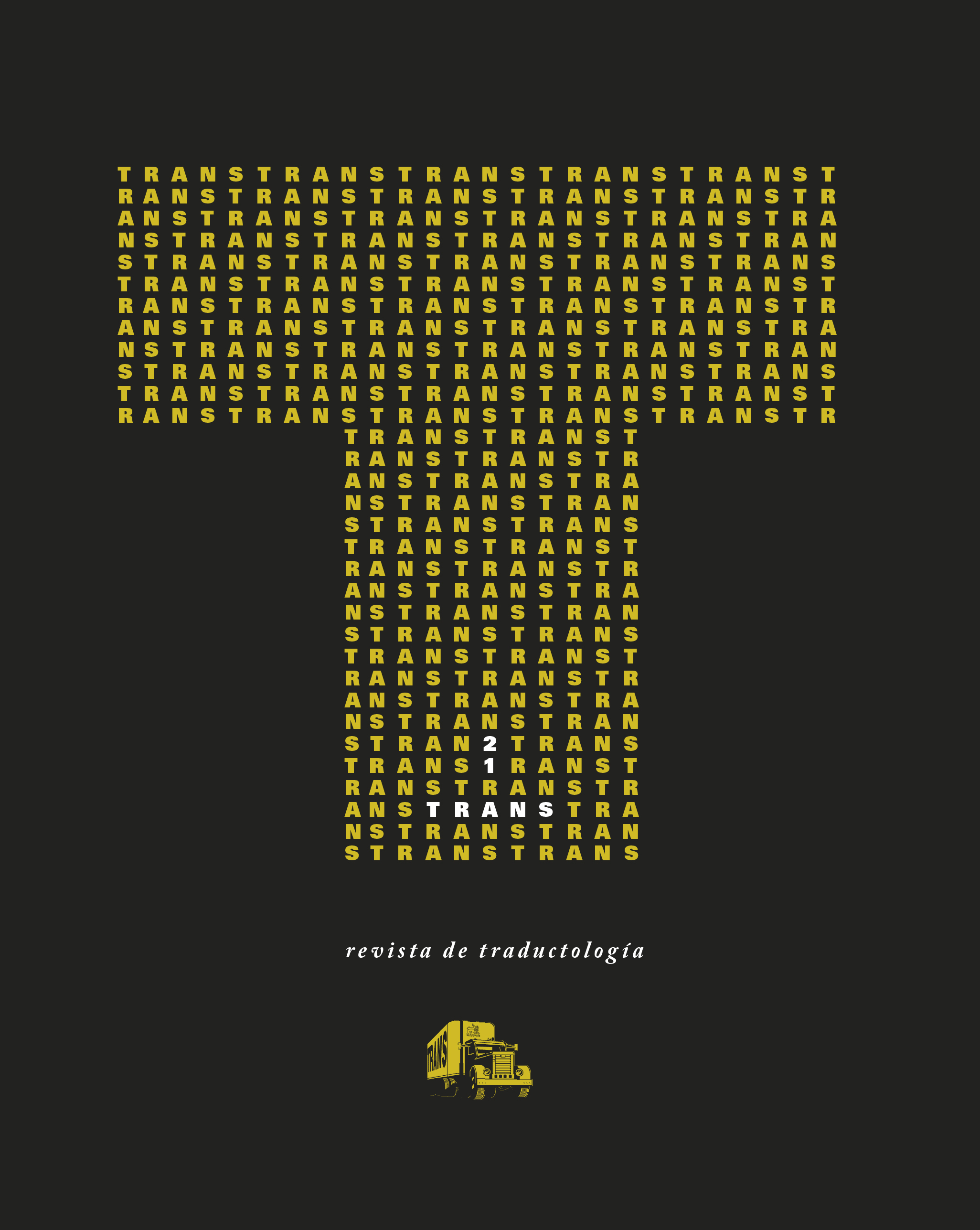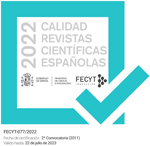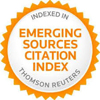Film ininflamable o le roman vague
DOI:
https://doi.org/10.24310/TRANS.2017.v0i21.3636Palabras clave:
El Quijote, Nouvelle vague, Quijotesco, Objeto-libro, Iconografía, Medio fílmicoResumen
Este artículo pretende ensayar un acercamiento transversal a la presencia en pantalla de El Quijote (libro y tema). Abordándolo no desde el punto de vista de la adaptación convencional, si no desde la redefinición que de su legado textual y poético —tanto en lo personal, como en lo visual y cultural— han realizado cineastas como Jean-Luc Godard, Jacques Rivette, François Truffaut o Éric Rohmer, asociados a la Nouvelle Vague: una generación brulê por la pasión lectora y espectadora. Constituye la tela de fondo de esta reflexión una cadena
formada por la pauta iconográfica del objeto-libro abrasado, instaurada por F. W. Murnau en Faust (1926), la paradójica reescritura que el fuego hace de la obra de Cervantes en el Don Chisciotte (1933) de G. W. Pabst, y la voluntad quijotesca del propio medio fílmico, representada por el Quijote inacabado de Orson Welles (1957-1985). Todo ello, conectado con la propia naturaleza inflamable de la textura del viejo cine y de los viejos libros (fábula de Fahrenheit 451 novela y film).
Descargas
Métricas
Publicación Facts
Perfil de revisores N/D
Información adicional autores
Indexado: {$indexList}
-
Indexado en
- Sociedad Académica/Grupo
- N/D
- Editora:
- Universidad de Málaga
Citas
Benoliel, Bernard (2014): «La peu et les os». François Truffaut. Serge Toubiana (dir.), Paris: Flammarion/ La Cinémathèque Français, 16-17.
Berriatúa, Luciano (1990): Los proverbios chinos de F.W. Murnau. Etapa alemana. Madrid: Filmoteca Española/ Instituto de Cinematografía y de las Artes Audiovisuales.
Bonitzer, Pascal (1995): «El gesto o el acto». Viridiana 9, 95-99.
Cherchi Usai, Paolo (2005): La muerte del cine. Barcelona: Laertes. Traducción de Emili Olcina.
Fernández Heredero, Carlos (1995): «Cine, relato y representación en el sistema narativo de Le Genou de Claire». Viridiana 9, 101-09.
Herranz, Ferrán (2005): El Quijote y el cine. Madrid: Ediciones Cátedra.
Jaouan-Sánchez, Marie-Pierre (2003): «L’Étrange Histoire d’une adaptation cinématographique de Don Quichotte dans la France des années folles (Morand, Pabst, 1932-1933)». Don Quichotte au
xxe siècle; réceptions d’una figure mythique dans la littérature et les arts.31 Daniel Perrot (ed.), Clermont-Ferrand: Presses Universitaires Blaise Pascal.
Liandrat-Guigues, Suzanne y Leutrat, Jean-Louis (1994): Jean-Luc Godard. Madrid: Ediciones Cátedra.
Liandrat-Guigues, Suzanne y Leutrat, Jean-Louis (2009): «Lemmy Caution rencontre Don Quichotte». Lendamains (Hommages à Michael Nerlich), 133-139.32
Rohmer, Éric (1995): «Le Genou de Claire».33 Viridiana 9, 21-94. Traducción de Socorro Thomás.
Rohmer, Éric (2000): Seis cuentos morales. Barcelona: Anagrama.
Traducción de Joaquín Jordá.
Sánchez-Biosca, Vicente (2009): «El Quijote sin canon. Notas sobre Don Quichotte (GeorgeWilhelm Pabst, 1933)». El cine y el Quijote, C. F.Heredero (ed.), Madrid: Sociedad Estatal de Conmemoraciones Culturales, 175-179.
Sánchez, Bernardo (2002): «Lo vago y lo nuevo. Una
vela a Faulkner y otra a Balzac». En torno a la Nouvelle Vague. Rupturas y horizontes de la modernidad,C. F. Heredero y José Enrique Monterde (eds.), Valencia: Institut Valenciá de Cinematografía/
Festival Internacional de Cine de Gijón/Centro Galego de Artes da Imaxe/ Filmoteca de Andalucía, 199-208.
Siety, Emmanuel (2007): «“Quelques Bêtes dans la jungle”: la reencontré dans les Films de Jacques Rivette; Céline et Julie vont en bateau (1974)». La reencontré: Au cinéma, toujours l’innatendu arrive, J.Aumont (dir.), Rennes: Presses universitaires de Rennes, 13-36.
Truffaut, François (1974): La noche americana (guión). Fahrenheit 451 (diario de rodaje). Valencia: Fernando Torres Editor. Traducción de Xavier Aleixandre.
Publicado
Cómo citar
Número
Sección
Licencia
Todos los contenidos publicados en TRANS. Revista de Traductología están sujetos a la licencia Creative Commons Reconocimento-NoComercia-Compartirigual 4.0 cuyo texto completo puede consultar en <http://creativecommons.org/licenses/by-nc-sa/4.0>
Se pueden copiar, usar, difundir, transmitir y exponer públicamente, siempre que:
- Se cite la autoría y la fuente original de su publicación (revista, editorial y URL de la obra).
- No se usen para fines comerciales.
- Se mencione la existencia y especificaciones de esta licencia de uso.
- Compartir Igual — Si remezcla, transforma o construye sobre el material, debe distribuir sus contribuciones bajo la misma licencia que el original.
Los derechos de autor son de dos clases: morales y patrimoniales. Los derechos morales son prerrogativas perpetuas, irrenunciables, intransferibles, inalienables, inembargables e imprescriptibles. De acuerdo con la legislación de derechos de autor, TRANS. Revista de Traductología reconoce y respeta el derecho moral de los autores/as, así como la titularidad del derecho patrimonial, el cual será cedido a la Universidad de Málaga para su difusión en acceso abierto. Los derechos patrimoniales, se refieren a los beneficios que se obtienen por el uso o divulgación de las obras. TRANS. Revista de Traductología se publica en open access y queda autorizada en exclusiva para realizar u autorizar por cualquier medio el uso, distribución, divulgación, reproducción, adaptación, traducción o transformación de la obra.
Es responsabilidad de los autores/as obtener los permisos necesarios de las imágenes que están sujetas a derechos de autor.
Los autores/as cuyas contribuciones sean aceptadas para su publicación en esta revista conservarán el derecho no exclusivo de utilizar sus
contribuciones con fines académicos, de investigación y educativos, incluyendo el auto-archivo o depósito en repositorios de acceso abierto de cualquier tipo.













21.png)
